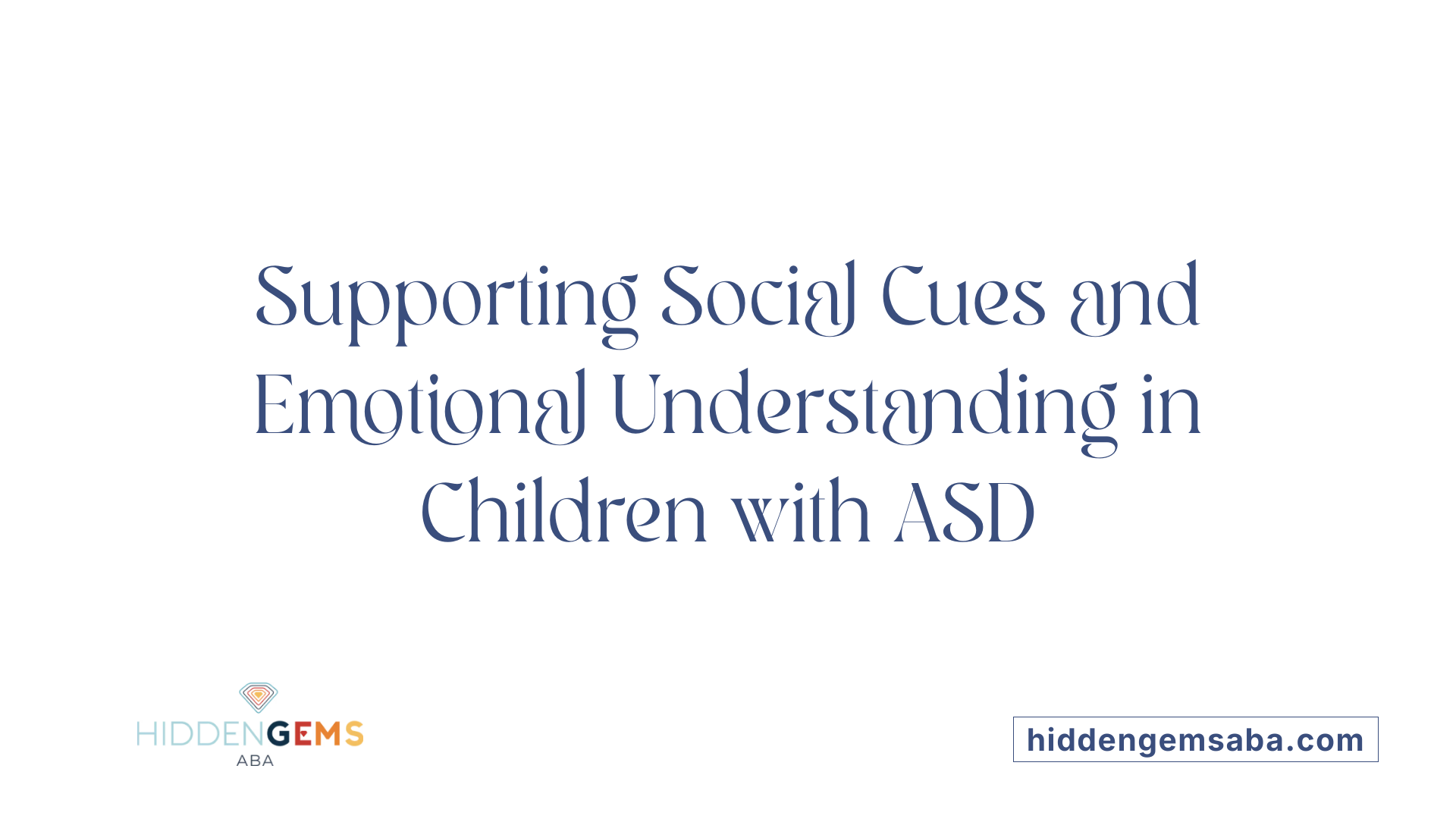Understanding the Communication Landscape in Autism
Autism Spectrum Disorder (ASD) affects communication and behavior in approximately 1 in 54 children, presenting unique challenges and opportunities. Effective communication is central to enhancing quality of life and social participation for children with autism. This article explores evidence-based therapies, practical techniques, technologies, and family roles that empower children with ASD to express themselves, build skills, and connect meaningfully with others.
Core Communication Challenges in Autism Spectrum Disorder

What Communication Difficulties Are Common in ASD?
Autism Spectrum Disorder (ASD) presents various challenges in behavior and communication that affect about 1 in 54 children. Many children with ASD experience difficulties with both verbal and nonverbal communication. These difficulties include struggles to interpret social cues such as facial expressions and body language, which are important for effective interaction.
What Are Common Autistic Behaviors That Affect Communication?
Children with ASD often exhibit behaviors that impact communication, including avoidance of eye contact, repetitive actions, and challenges in understanding the feelings and intentions of others. These behaviors can hinder social interactions and make it harder for them to engage with peers and adults.
How Do Nonverbal Communication Challenges Present in ASD?
Nonverbal communication, such as gestures, eye contact, and facial expressions, can be especially difficult for children on the autism spectrum. Many may avoid eye contact or have limited use of gestures, which are crucial for expressing needs and emotions. Nonverbal challenges can result in misunderstandings and increase social isolation.
Together, these communication challenges require tailored support strategies to enhance understanding and interaction for children with ASD.
Applied Behavior Analysis (ABA) Therapy: Foundation and Goals

What is Applied Behavior Analysis (ABA) therapy, and how is it used to support individuals with autism?
Applied Behavior Analysis (ABA) therapy is a science-based approach that helps individuals on the autism spectrum develop essential skills by analyzing and modifying behavior. ABA uses the ABC model — Antecedents, Behaviors, and Consequences — to understand why a behavior occurs and to encourage positive changes through techniques like positive reinforcement.
ABA programs target areas such as communication, social interaction, self-care, academic learning, and adaptive skills. Therapies are tailored to the individual's unique needs and may include structured methods like Discrete Trial Training (DTT), which breaks skills into simple steps reinforced by rewards, or more natural approaches like Pivotal Response Treatment (PRT), focusing on key communication skills in everyday settings. Trained professionals such as Board Certified Behavior Analysts (BCBAs) often oversee the interventions.
What are the main goals and benefits of ABA therapy for individuals on the autism spectrum?
The primary goals of ABA therapy are to improve communication, promote social skills, reduce challenging behaviors, and increase independence. This therapy supports individuals in gaining greater participation in daily life and community activities. Its evidence-backed strategies foster better adaptive functioning, helping children and adults alike to develop essential life skills.
Research shows that intensive ABA therapy, often administered for 20-40 hours per week, leads to meaningful developmental improvements. Early and consistent intervention can enable children to integrate more successfully into mainstream environments and achieve enhanced social acceptance and autonomy.
How ABA supports communication and behavior
ABA plays a central role in teaching communication by using reinforcement to encourage verbal or alternative communication methods. It helps replace disruptive behaviors with constructive skills, providing children with ways to express needs and emotions effectively. By focusing on individualized objectives, ABA empowers learners to succeed at their own pace and fosters positive interactions.
Intensity and evidence base of ABA
ABA therapy is widely accepted by healthcare and educational professionals as one of the most effective treatments for autism. Recommended intensities range from 20 to 40 hours per week, customized to each person's needs. Its strong scientific foundation derives from decades of research demonstrating improvements in language, socialization, and overall functionality, making it a cornerstone of autism intervention.
| Aspect | Details | Benefits |
|---|---|---|
| Definition | Science-based behavior modification using ABC model | Tailored interventions targeting communication, social, and adaptive skills |
| Techniques | Discrete Trial Training (DTT), Pivotal Response Training (PRT) | Structured and natural settings promoting skill acquisition |
| Goals | Improve communication, reduce challenging behaviors | Enhanced independence and social participation |
| Intensity | 20-40 hours per week | Intensive intervention correlates with improved developmental outcomes |
| Professional Oversight | Board Certified Behavior Analysts (BCBAs) | Expertise ensures individualized, effective therapy plans |
| Evidence Base | Extensive research supporting efficacy | Widely supported by healthcare and education communities |
Designing and Delivering ABA Therapy Programs

How is an ABA therapy program typically designed for an autistic individual?
ABA therapy programs start with a thorough assessment, including observation, standardized tests, and input from families and caregivers. This helps identify the child's unique strengths, challenges, and needs. Based on this assessment, individualized, functional goals are set to target vital areas such as communication, social skills, and daily living activities.
The therapy uses tailored strategies to teach and reinforce positive behaviors, like interpreting nonverbal cues and maintaining eye contact. Incorporating naturalistic environments and group settings encourages transferring skills to real-life situations. Progress is closely monitored with ongoing data collection and collaboration among therapists, families, and schools to adjust the program for maximum effectiveness.
What are some common techniques and interventions used in ABA therapy?
ABA therapy employs a variety of evidence-based techniques. Positive reinforcement encourages desirable behaviors by rewarding them.
Discrete Trial Training (DTT) breaks skills into small, manageable steps taught through repeated trials with clear instructions and reinforcements. Prompting and fading help guide the learner initially and gradually reduce assistance.
Visual aids like charts, pictures, and video modeling support learning by making instructions clearer. Behavior chaining breaks complex tasks into sequenced steps for easier learning.
Other methods include behavior contracts and extinction to reduce unwanted behaviors, modeling to demonstrate skills, redirection, script fading, and Functional Communication Training (FCT) to develop purposeful communication.
Together, these techniques are chosen and adapted to the individual's profile, ensuring ABA therapy is both personalized and effective in promoting meaningful skill acquisition and behavioral improvements.
Providers and Professional Qualifications in ABA Therapy

Who Typically Provides ABA Therapy, and What Qualifications Should These Professionals Have?
ABA therapy is delivered by professionals trained in behavioral analysis and autism interventions, including Board Certified Behavior Analysts (BCBAs), licensed psychologists, and behavioral therapists.
To become a qualified ABA therapist, individuals generally hold at least a master's degree in psychology, education, or related fields. Obtaining BCBA certification requires completing specialized graduate coursework and accumulating between 1,000 to 2,000 hours of supervised field experience.
These professionals conduct behavioral assessments, design personalized treatment plans, and apply positive reinforcement to teach skills like communication, social interaction, and daily living tasks. They play an essential role in guiding progress and tailoring interventions to meet each child's unique needs.
ABA providers work closely with families, educators, and other healthcare professionals to ensure consistent implementation and monitor treatment effectiveness. Collaboration is vital to align therapy goals and support development across different environments.
Ongoing education and training are required for ABA therapists to maintain their certification and stay informed about evidence-based practices and evolving research in autism care.
Complementary Communication Tools and Therapies

How do communication boards and PECS support children with autism?
Communication boards and the Picture Exchange Communication System (PECS) are vital tools for nonverbal children with autism. Communication boards use images and symbols to allow children to express their needs and feelings without speaking. PECS builds on this by teaching children to make requests with pictures, fostering communication development and encouraging interaction, often resulting in small to moderate gains.
What role do speech generating devices (SGDs) play?
Speech generating devices digitally produce spoken words, providing a voice for children who struggle to speak. These devices enhance social interaction and communication but may require investment due to their cost. They offer a versatile way to support language development by enabling children to form complex phrases beyond simple picture exchanges.
How do sign language and visual supports aid communication?
Sign language, such as American Sign Language (ASL), can be an effective communication mode for many children with autism. While it may present challenges, learning signs facilitates expressive and receptive communication. Visual supports—including pictures, visual schedules, and concrete illustrations—are crucial because many autistic children are visual learners. These aids help link words to images, simplifying understanding and encouraging language use.
In what ways is technology integrated into therapy?
Technology, such as tablets and iPads, plays an increasingly important role by offering interactive applications tailored to children with limited verbal skills. These devices assist in formulating thoughts and expanding language complexity. Therapists often use simple visual templates and picture descriptions within these tools to teach vocabulary and sentence structures, supporting individualized learning in a fun and engaging way.
The Vital Role of Families in ABA and Communication Development
What Role Do Families Play in the Success of ABA Therapy?
Families are indispensable in the success of Applied Behavior Analysis (ABA) therapy for children with autism. By providing consistent support in everyday routines, families help reinforce the communication and behavioral skills taught during therapy. This consistency encourages generalization, meaning the child can apply skills learned in structured sessions to real-life situations.
Parental involvement also ensures that progress continues beyond the therapy setting. When parents collaborate actively with therapists, they help tailor intervention goals to their child’s unique strengths and needs. Such partnership promotes individualized care and responsiveness.
Essential to this collaboration is the training and empowerment of parents. Learning ABA techniques equips families to implement strategies at home, enhancing the child's communication development effectively. This training also includes data collection, allowing caregivers to track improvements and challenges, making it easier to adjust approaches as needed.
Moreover, families provide vital emotional support, encouragement, and advocacy for their child. They create a nurturing environment that fosters confidence and motivation, which are crucial for sustained progress.
In summary, the combined efforts of families and therapists ensure that behavioral and communication skills are not only acquired but also maintained and generalized, leading to more meaningful and lasting developmental outcomes for children with autism.
Considerations and Criticisms of ABA Therapy

Are there any criticisms or limitations associated with ABA therapy?
Applied Behavior Analysis (ABA) therapy is widely used to support children with autism, but it also faces significant criticisms and limitations. One concern is its intensity; ABA often requires 20-40 hours of sessions weekly, which can be overwhelming for some individuals and families. Critics argue that ABA sometimes places too much emphasis on compliance and conformity, aiming to reduce behaviors such as stimming that provide comfort and self-regulation. This focus can suppress natural ways autistic individuals cope with their environment.
Furthermore, some practitioners might prioritize making autistic individuals appear more neurotypical, potentially causing emotional distress. Harsh or insensitive application of ABA techniques has been reported to cause trauma or symptoms similar to PTSD in certain cases. Critics also highlight that ABA’s behavior modification approach may overlook intrinsic thoughts, feelings, and the unique strengths of autistic individuals.
In response to these concerns, there is a growing emphasis on ethical, respectful, and individualized practice within ABA. This involves tailoring therapy to a person’s needs, respecting neurodiversity, and avoiding approaches that amount to masking or erasing authentic autistic traits. Incorporating the principles of neurodiversity encourages valuing diverse ways of thinking and communicating rather than enforcing conformity.
Thus, while ABA can be beneficial when applied thoughtfully, its criticisms highlight the necessity of ethical standards and supporting autistic individuals in ways that honor their individuality and well-being.
Building Bridges Through Tailored Communication Support
Effective communication for children with autism requires a multidimensional approach tailored to individual needs. Applied Behavior Analysis (ABA) therapy stands out as a cornerstone intervention, offering evidence-based strategies to develop essential skills and foster independence. When combined with assistive communication tools, family involvement, and ethical, respectful practice, these interventions can transform challenges into meaningful progress. Recognizing and respecting the unique communication styles of autistic individuals—rather than enforcing conformity—helps bridge gaps between autistic and non-autistic communities. Ultimately, fostering supportive environments where children with autism can express themselves freely enriches their social connections and enhances quality of life.
References
- 7 Autism Behavior and Communication Strategies | NU
- Teaching nonverbal autistic children to talk
- Treatment and Intervention for Autism Spectrum Disorder
- Autism Communication Strategies: Tips for Implementation
- Autism and communication
- How to Become an ABA Therapist - School of Education
- The Role of Caregiver Involvement in ABA Therapy
- Why Family Involvement Enhances ABA Therapy
- Helping Parents Understand Applied Behavior Analysis
- The Role of Family in ABA Therapy: Tips for Parents






